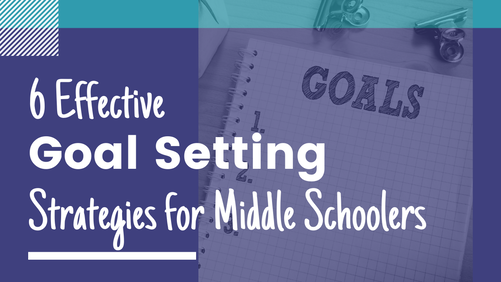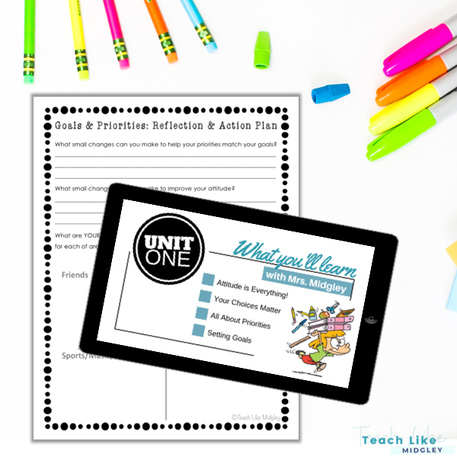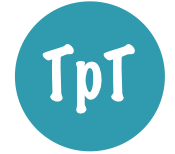6 Effective Goal Setting Strategies
for Middle Schoolers
|
Would you rather listen? Click play to hear the post:
|
Goal setting is a very natural to start the new school year, the new semester, or the new calendar year.
Many teachers look for activities and lessons to get their students started with setting goals, especially in middle school.
This makes complete sense, because at the middle school level, students are developmentally at a stage where setting goals is ideal.
However, there is one very big mistake that most teachers make when teaching goal setting. VERY BIG MISTAKE.
Well, since I know you’re curious... let me tell you.
The biggest mistake teachers make with goal setting, is treating it as a one-time activity. They help students set goals and then move on.
Now you might be thinking that you aren’t making this mistake, because you help students set goals, and then you look to see later on if they’ve been met. You’ll be relieved to know that you are part way there, but you’re still not teaching goal setting effectively.
This approach to goal setting actually sets students up for failure. Not just with their goal, but with using goal setting in general.
Goal setting is a cycle. And there are multiple steps that must be taken if goal setting is to be effective.
In this post, you’ll learn an effective process that will help you teach goal setting to your students.
Self-Evaluate Frequently
The first step in goal setting is always to evaluate where you currently stand. Sometimes this means answering some tough questions. But most importantly, you must be honest with yourself, even when it’s hard.
You will want your students to start by looking at what they have achieved in the past, along with reflecting on choices they have made. This includes, but is not limited to: current/past grades, performance in different areas of class (tests, homework, etc.), behavior, attitude, effort and work ethic.
Self-evaluating is a step that you want to teach your students to do on a regular basis. The length of time allowed to achieve the goal, will have a lot to do with deciding how often to self-evaluate.
A great approach is to have students self-evaluate at the start of a grading period, after each unit test, and at the end of the grading period.
You will want your students to start by looking at what they have achieved in the past, along with reflecting on choices they have made. This includes, but is not limited to: current/past grades, performance in different areas of class (tests, homework, etc.), behavior, attitude, effort and work ethic.
Self-evaluating is a step that you want to teach your students to do on a regular basis. The length of time allowed to achieve the goal, will have a lot to do with deciding how often to self-evaluate.
A great approach is to have students self-evaluate at the start of a grading period, after each unit test, and at the end of the grading period.
Attitude is Everything
Common complaints among students are that they can’t succeed in a particular class because either 1 – the teacher doesn’t like them 2 – they don’t like the class 3 – they don’t like the subject.
Unfortunately, this is the reality. At least for that student. Once you have decided you can’t do something, then your chances of finding success are very, very low.
We must help students overcome these mindsets. It’s the only way they can find success and achieve their goals.
As people, we know that we are all different. And since we are all different, chances are good we will encounter other people throughout our lives that we don’t like, for whatever reason. But the lesson is that we shouldn’t let that stop us from being kind and respectful.
It is the same concept with learning. You may not like the teacher. You may not like the class. You may not like the subject. But that doesn’t mean you dwell on it and let it stop you from being successful. Sometimes we must look at the larger goal at the other end, and realize this is a step we must conquer in order to keep going. And that is where the motivation lives. In our drive to reach our goal that’s on the other side of the task we don’t like.
A great way to help students see this, is within your own teaching. Chances are, there is a unit you don’t care for much. But you teach it anyways. And I’d be willing to bet that you put the same effort into that unit as you do for the others. Share this with your students.
Share with students some of the things you must do, even if you don’t like it. And help them see that you do it for a purpose. And that having a good attitude about it is a choice you make.
Unfortunately, this is the reality. At least for that student. Once you have decided you can’t do something, then your chances of finding success are very, very low.
We must help students overcome these mindsets. It’s the only way they can find success and achieve their goals.
As people, we know that we are all different. And since we are all different, chances are good we will encounter other people throughout our lives that we don’t like, for whatever reason. But the lesson is that we shouldn’t let that stop us from being kind and respectful.
It is the same concept with learning. You may not like the teacher. You may not like the class. You may not like the subject. But that doesn’t mean you dwell on it and let it stop you from being successful. Sometimes we must look at the larger goal at the other end, and realize this is a step we must conquer in order to keep going. And that is where the motivation lives. In our drive to reach our goal that’s on the other side of the task we don’t like.
A great way to help students see this, is within your own teaching. Chances are, there is a unit you don’t care for much. But you teach it anyways. And I’d be willing to bet that you put the same effort into that unit as you do for the others. Share this with your students.
Share with students some of the things you must do, even if you don’t like it. And help them see that you do it for a purpose. And that having a good attitude about it is a choice you make.
Set the Goals
Actual setting goals can be tricky business. And the right way to set goals often depends on what type of motivation works best for the individual.
The most successful approach for students that I have witnessed, involves small goals first. Most students need to see some success in order to build their confidence in being able to tackle larger goals.
Smaller goals might include turning homework in on time, keeping a notebook organized, or practicing vocabulary words during the last 10 minutes of class.
While long term goals are great for providing motivation to get through a class you may not like, the short term goals are where students build confidence in themselves.
The most successful approach for students that I have witnessed, involves small goals first. Most students need to see some success in order to build their confidence in being able to tackle larger goals.
Smaller goals might include turning homework in on time, keeping a notebook organized, or practicing vocabulary words during the last 10 minutes of class.
While long term goals are great for providing motivation to get through a class you may not like, the short term goals are where students build confidence in themselves.
Make a Plan
Anyone can say they want to go to college and be a veterinarian. But that doesn’t mean they know the steps to actually make it happen. This is where you come in, as the teacher. Helping students identify steps to make their goals happen, whether they are long or short goals.
Maybe in involves regular study time. Maybe it involves reaching out to someone for help – like the counselor. Maybe it involves a post-it on the notebook as a reminder that can be seen every day. You can help students reach the goals they set for your class by providing them with a selection of tasks/actions they can take. These might be: writing down their assignment each day in their planner or strategies for practicing vocabulary words.
Maybe in involves regular study time. Maybe it involves reaching out to someone for help – like the counselor. Maybe it involves a post-it on the notebook as a reminder that can be seen every day. You can help students reach the goals they set for your class by providing them with a selection of tasks/actions they can take. These might be: writing down their assignment each day in their planner or strategies for practicing vocabulary words.
Choices Matter - Determine Priorities
The next step in the goal setting cycle is to help students understand the connection between reaching their goals and the choices they make every day. They may be sitting there looking at a fabulous plan, but no idea when or how to make it happen.
This is a natural place for time management skills to be part of your lesson. While there are many things in our day to day lives that our out of our control, when you look closely, you’ll see that there’s a lot of time actually within our control. And it’s using the time within our control that is the key to getting things done to help us reach our goals.
Understanding what the term prioritize means, should be at the top of your list for teaching goal setting to your middle schoolers. What you choose to do, will have a direct reflection on if you reach your goals.
It’s important to also clarify for your students that you’re not trying to say they can’t have any fun. In fact, I tell students the opposite! Fun is important! Schedule it in! Just realize there is a time to have fun and there’s a time to get stuff done. I am a firm believer that you need both.
This is a natural place for time management skills to be part of your lesson. While there are many things in our day to day lives that our out of our control, when you look closely, you’ll see that there’s a lot of time actually within our control. And it’s using the time within our control that is the key to getting things done to help us reach our goals.
Understanding what the term prioritize means, should be at the top of your list for teaching goal setting to your middle schoolers. What you choose to do, will have a direct reflection on if you reach your goals.
It’s important to also clarify for your students that you’re not trying to say they can’t have any fun. In fact, I tell students the opposite! Fun is important! Schedule it in! Just realize there is a time to have fun and there’s a time to get stuff done. I am a firm believer that you need both.
Continue the Cycle
Reflect, set a goal, make a plan, work the plan, reflect, adjust, work the plan some more.
One of the more crucial parts of goal setting is the step where you reflect on your progress and make adjustments to the plan if needed.
Too often students are quick to say they can’t do it – but it’s usually just because they need to either adjust the plan or actually do the plan.
We see this in school with academics, at home and even with building a business. It’s not the goal that needs to change, it’s the action plan to get there.
One of the more crucial parts of goal setting is the step where you reflect on your progress and make adjustments to the plan if needed.
Too often students are quick to say they can’t do it – but it’s usually just because they need to either adjust the plan or actually do the plan.
We see this in school with academics, at home and even with building a business. It’s not the goal that needs to change, it’s the action plan to get there.
Ready to Roll Materials
Now that you have a good idea of what your middle school students really need to help them set goals, you are ready to get started.
But if you are looking for a more streamlined approach and materials to help you get the job done, as always, I’m totally here for you!
You may want to check out these two resources:
Study Skills: Setting Goals and Priorities Video Lesson which includes a flipped classroom video along with guided notes and an action plan (printable and digital versions included).
Or if you’re looking for something a little more in-depth, check out Chapter One Setting Goals and Priorities from my Study Skills Course Curriculum.
But if you are looking for a more streamlined approach and materials to help you get the job done, as always, I’m totally here for you!
You may want to check out these two resources:
Study Skills: Setting Goals and Priorities Video Lesson which includes a flipped classroom video along with guided notes and an action plan (printable and digital versions included).
Or if you’re looking for something a little more in-depth, check out Chapter One Setting Goals and Priorities from my Study Skills Course Curriculum.
You May Also Be Interested In...
Let's Connect...

Welcome! I'm Hillary Midgley, a veteran 6th grade teacher.
I create educational materials and develop curriculum for other teachers. I specialize in teaching students how to learn through my Study Skills Curriculum. I have established fundamental classroom systems and structures for teachers to help them streamline their classroom. And my passion is teaching ancient history through engaging activities with foundations in academic skills. Here you will find resources on all of these topics and more. Learn more about me here.
|










